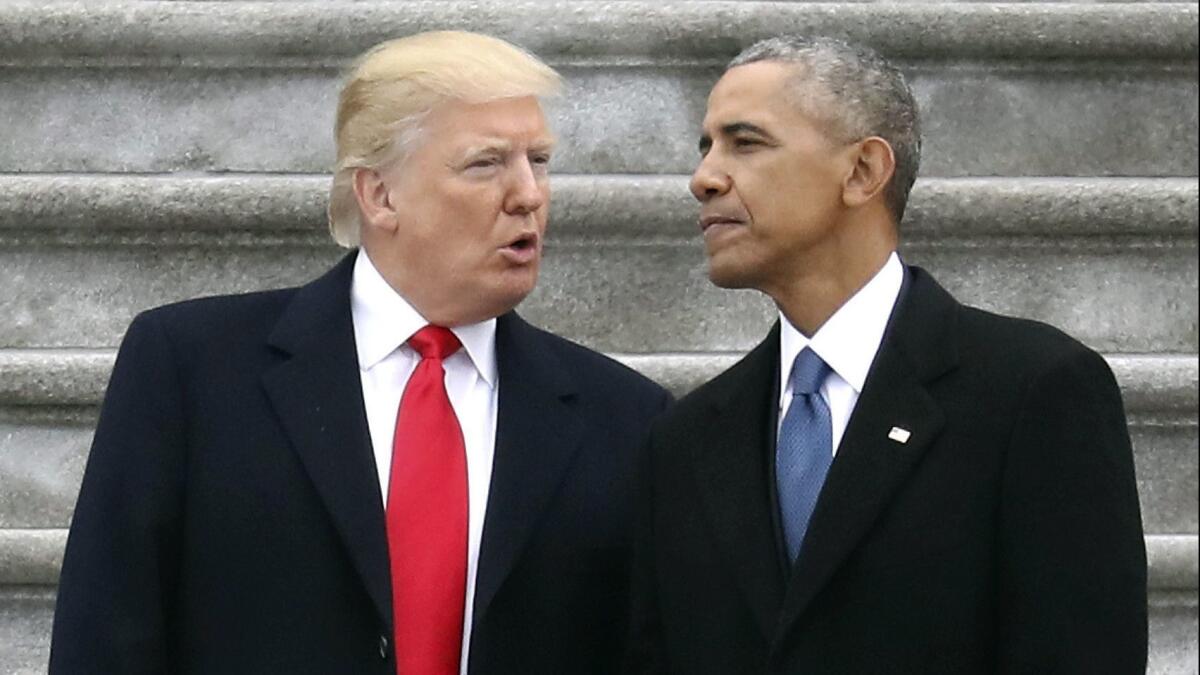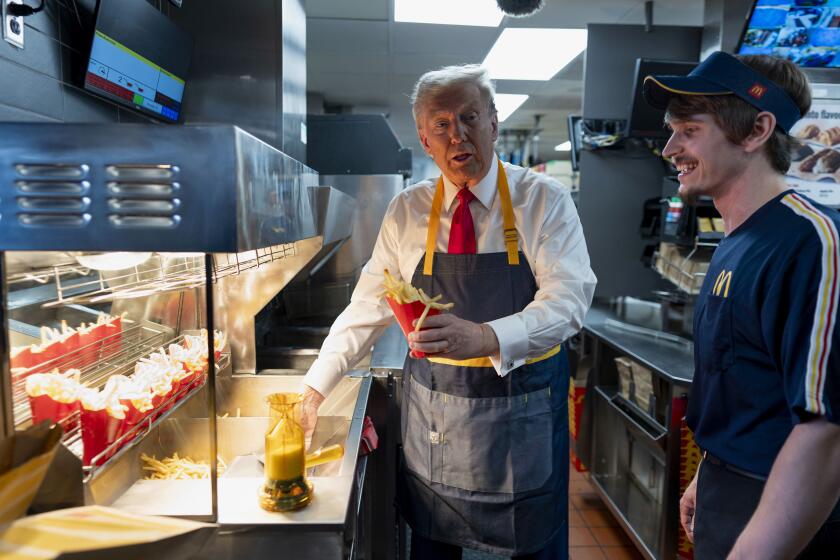Trump vs. Obama: Who has the better record on the U.S. economy?

- Share via
WASHINGTON — As the campaign enters the home stretch, President Trump’s main closing argument is that he deserves four more years because he oversaw “the greatest economy in the history of our country.”
But even looking at the three years before COVID-19 made a mess of things, the U.S. economy under Trump performed about the same as it had during the last three years under President Obama. On some economic measures, it was a little worse, on others a little better — but on the whole, not markedly different. And it was a far cry from the best ever.
Consider: Under Obama from 2014 to 2016, real gross domestic product — the broadest measure of economic activity — grew at an average annual rate of 2.5%. In Trump’s first three years, 2017 to 2019, real GDP expanded by an annual average of 2.6%, according to the Bureau of Economic Analysis.
In December 2017 , Trump had talked about GDP rocketing to “4, 5, and maybe even 6% or higher.” But despite his big corporate tax cut, GDP growth didn’t come close to reaching the average yearly gains of 4% in the 1990s and twice that in the early 1950s.
On Thursday the government will release the third-quarter GDP report, which is expected to show a strong recovery from the 31.4% plunge in the prior quarter. Still, for the year as a whole, GDP is projected to fall close to 4% thanks to the pandemic, the sharpest drop in about 75 years.
On employment, the U.S. economy added 6.6 million jobs in Trump’s first three years, shy of the 8.1 million payroll gains in the last three years under Obama.
Trump has often bragged about his record on production jobs, which has particular appeal to his working-class base and to voters in the Midwest. But even here, the difference isn’t much at all.
From the end of 2016 to the close of 2019, the nation added 1.27 million jobs in the blue-collar industries of construction and manufacturing, although factory jobs flattened in 2019 thanks in part to Trump’s trade war with China. That compared with 1.13 million construction and manufacturing jobs gained from 2014 to 2016, according to the Bureau of Labor Statistics.
It’s true that the nation’s unemployment rate fell to a half-century low of 3.5% before the coronavirus outbreak in March, and that jobless figures for Latinos, Blacks and Asians also dropped to the lowest level on record. But economists note that the actual change in unemployment rates over their respective three-year periods was bigger under Obama than under Trump.
In recent months, the Trump campaign has talked about how American household incomes rose faster during Trump’s first three years in office than during the entire eight-year period under Obama. That’s technically correct — median income, adjusted for inflation, went up 5.8% from 2008 to 2016 versus 7.8% from 2016 to 2019, according to the Census Bureau.
But that doesn’t take into account that Obama and Vice President Joe Biden entered office in the middle of the Great Recession. It wasn’t until 2013 that household income stopped bleeding and a recovery began.
Looking at just the last three years of the Obama administration, median income grew by 8.4%, a slightly faster pace than during Trump’s first three years as president.
One measure that has clearly outperformed under Trump is the stock market. The broad Standard & Poor’s 500 index jumped by an annual average of 14.7% from the end of December 2016 to year-end 2019 — about double the gain in the comparable period of Obama’s last three years.
But only a small percentage of Americans own substantial amounts of securities, and market fluctuations have relatively little impact on their daily lives. By comparison, the price of homes, which are held much more widely by Americans, rose on average 4.8% in Trump’s first three years versus 4.9% during Obama’s last three, according to Mark Zandi of Moody’s Analytics.
Trump has consistently held up stock performance as a report card of his stewardship of the economy. The president said in his debate last week that a Biden presidency would be a calamity for the stock market.
But investors pushed up stocks earlier in the fall on rising bets that a Biden victory combined with Democrats taking the Senate and maintaining the House — a so-called blue wave — would actually be a plus for the economy, at least in the short term.
That’s because a unified Democratic government increases the odds of a large fiscal stimulus and infrastructure investment, something along the lines of Biden’s proposal for $2.1 trillion on developing the green economy as well as for traditional projects like roads and bridges.
A Democratic sweep, however, also has potential downside risks for stocks and the economy: Biden has proposed an increase in taxes for corporations and wealthy Americans. That could crimp corporate earnings, eventually spilling into stock values.
At the same time, Jack Ablin, chief investment officer at Cresset Capital in Chicago, noted that Trump’s corporate tax cuts in 2017 didn’t trickle down to boost business spending as promised. Instead, record amounts were used for stock buybacks and returned to investors as dividends, which helped pump up the stock market but did far less for the broader economy.
That’s one reason GDP growth never took off. But lower taxes and less-than-projected government revenue generation, combined with hefty federal spending especially on defense, also sharply raised the nation’s debt levels.
The U.S. budget deficit was larger under Trump in his first three years — about $2.5 trillion — compared with $1.6 trillion under Obama in his last three years, according to the Congressional Budget Office.
If the side-by-side economic comparisons between Trump and Obama are not vastly different, to some degree that reflects the fact that presidents, for all the credit and blame they sometimes claim and get for what happens to the economy, in truth have limited control over the economy.
For much of the year, surveys have shown that Americans view Trump as better for the economy than Biden, although more recently that lead has diminished in some polls.
And even with the pandemic sending the country into recession and darker days almost certainly ahead, Trump garnered an approval rating of 54% on the economy in the latest Gallup poll. That’s second only to President Clinton’s 57% in 1996 among recent presidents who won reelection.
Experts say Trump’s more favorable ratings on the economy, compared with other issues including race relations and foreign affairs, reflect in part his reputation as a businessperson, though information on his income, wealth and taxes remain largely hidden from the public. Economist Zandi adds that the buoyant stock market has helped Trump’s approval rating on the economy, although he calls it ironic.
“The market is up only because the economy is struggling and interest rates are thus low and likely to remain so for some time,” he said.
More to Read
Get the L.A. Times Politics newsletter
Deeply reported insights into legislation, politics and policy from Sacramento, Washington and beyond. In your inbox three times per week.
You may occasionally receive promotional content from the Los Angeles Times.











